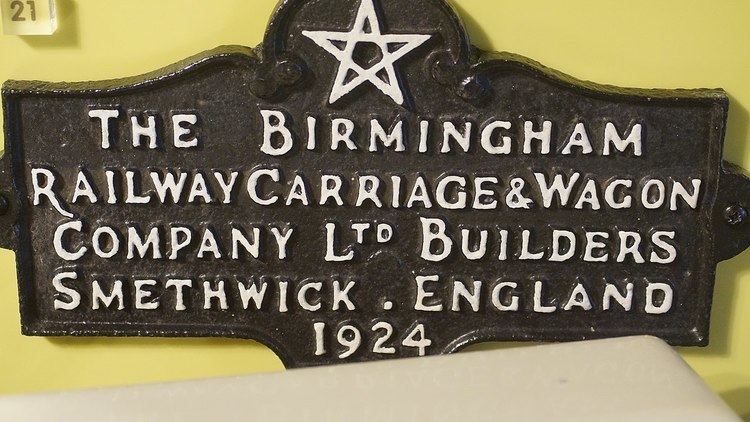Founded 1854 | ||
 | ||
Headquarters Birmingham, United Kingdom | ||
The Birmingham Railway Carriage and Wagon Company (BRC&W) was a railway locomotive and carriage builder, founded in Birmingham, England and, for most of its existence, located at nearby Smethwick, with the factory divided by the boundary between the two places. The company was established in 1854.
Contents
Production
BRC&W made not only carriages and wagons, but a range of vehicles, from aeroplanes and military gliders to buses, trolleybuses and tanks. Nevertheless, it is as a builder of railway rolling stock that the company is best remembered, exporting to most parts of the new and old worlds. It supplied vehicles to all four of the pre-nationalisation "big four" railway companies (LMS, SR, LNER and GWR), British Rail, Pullman (some of which are still in use) and Wagons-Lits, plus overseas railways with diverse requirement including Egypt, India, Iraq, Malaya, Mandate Palestine, South Africa and Nigeria. The company even built, in 1910, Argentina's presidential coach, which still survives, and once carried Eva Perón. Before World War II, the company had built steam-, petrol- and diesel-powered railcars for overseas customers, not to mention bus bodies for Midland Red, and afterwards developed more motive power products, including BR's Class 26, Class 33 (both diesel) and Class 81 (electric) locomotives. Examples of all three types are preserved.
Wartime production
The company built hospital trains during the Second Boer War. Handley Page bombers and Airco DH10s in World War I.
During World War 2, the company had a major impact on tank production as one the many companies building the A10 Cruiser tank, Valentine tank, Churchill tank, Cromwell tank and Challenger tank). They led the design and production of the Cromwell tank in liaison with Rolls Royce and Rover on the Meteor engine.
The company also built Hamilcar gliders in 1939-1945.
Locomotives
Some of the locomotives and multiple units built by the company are listed below:
Diesel Locomotives
Electric Locomotives
Diesel Multiple Units
Electric Multiple Units
Closure
In the years running up to 1963 the company had built an extensive number of locomotives, multiple units, and Underground cars, but then rapidly got into financial difficulties, and the business closed down. The self-funded prototype Lion main line locomotive was a particular disappointment, powered by a Sulzer 2,750 hp diesel engine, it was pitted against another self-funded prototype, Falcon, built by Brush at Loughborough which had twin 1,400 hp Maybach engines; after trials British Railways preferred the BRCW approach, but ordered them to be built by the Brush company; they became British Rail Class 47.
In June 2014 the company reformed as a not-for-profit organisation to rebuild prototype locomotives from the 1960s that were lost to the scrap man, including D0260 Lion. At the time of writing (January 2015) the company has identified an area of the old South Works site that will provide a suitable location for their headquarters. Other sites are also being evaluated which could prove to be better suited to the company's requirements.
